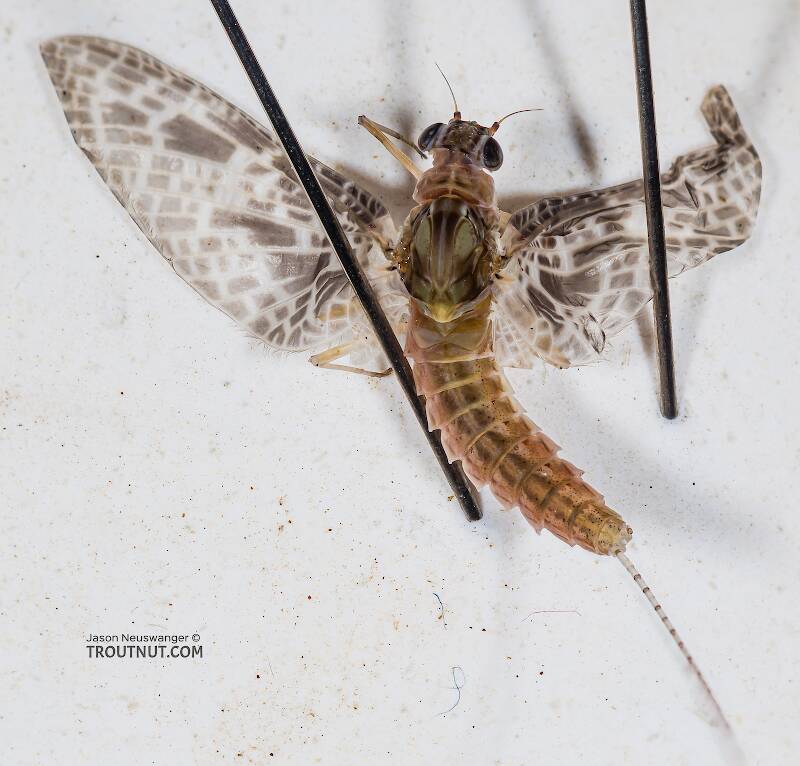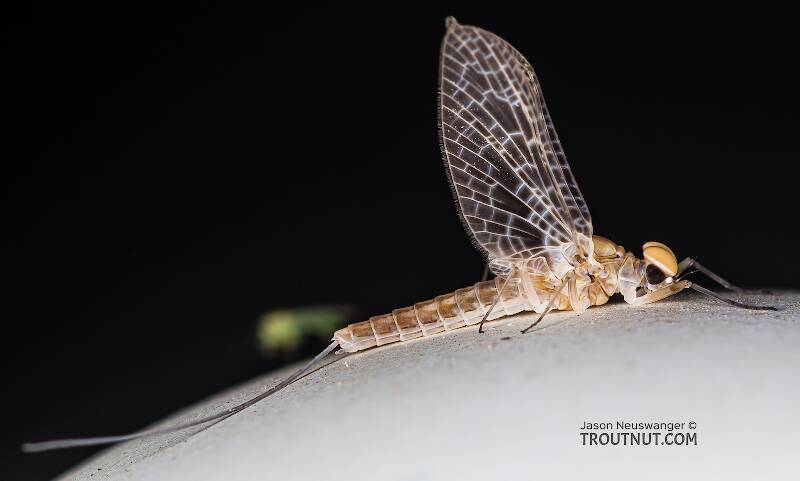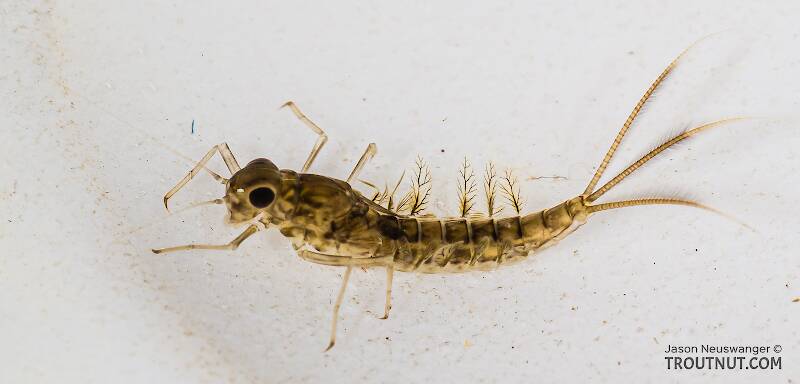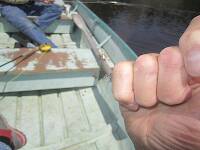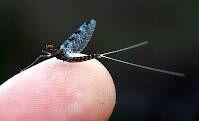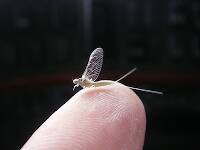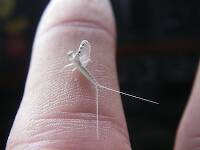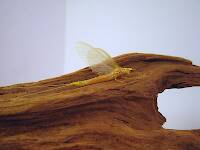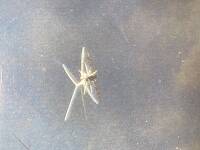
Blue-winged Olives
Baetis
Tiny Baetis mayflies are perhaps the most commonly encountered and imitated by anglers on all American trout streams due to their great abundance, widespread distribution, and trout-friendly emergence habits.
Featured on the forum

This one was surprisingly straightforward to identify. The lack of a sclerite at the base of the lateral hump narrows the field quite a bit, and the other options followed fairly obvious characteristics to Clostoeca, which only has one species, Clostoeca disjuncta.

Troutnut is a project started in 2003 by salmonid ecologist Jason "Troutnut" Neuswanger to help anglers and
fly tyers unabashedly embrace the entomological side of the sport. Learn more about Troutnut or
support the project for an enhanced experience here.
This topic is about the Mayfly Species Callibaetis ferrugineus
The sub-species Callibaetis ferrugineus ferrugineus and Callibaetis ferrugineus hageni taken together are by far the most important Callibaetis taxon in American trout waters. In extant angling literature, the sub-species ferrugineus ferrugineus inhabiting the east and Midwest is referred to as ferrugineus sans the sub-species name. In the West, Callibaetis ferrugineus hageni is referred to by many old and familiar synonyms, such as americanus, nigritus, and coloradensis. While important in the East and Midwest, it is in the West where Callibaetis ferrugineus hageni has achieved legendary status. Many western stillwater anglers look to the hatches of these speckled duns and spinners as the highlight of their seasons and have coined the phrase "gulpers" to describe the trout's feeding activity. In the West, some spring fed lower elevation lakes with longer growing seasons can produce as many as three discrete broods. In typical baetid fashion, these broods will be larger and darker in the Spring tending smaller and lighter as the season progresses.Example specimens
WildcatRob on Sep 8, 2007September 8th, 2007, 1:34 pm EDT
With almost 40 years lake fishing experience in the Northwest (Washington) our callibaetis always seem to start hatching mid afternoon in the evening, mate overnight then the spinners start in the morning. The spinners draw the most intense "rise." I put rise in quotes because it is so delicate there it leaves almost no disturbance at all not even a sip.
Any comments? Hopefully contradictions?
Rob
Any comments? Hopefully contradictions?
Rob
Taxon on Sep 8, 2007September 8th, 2007, 9:19 pm EDT
Rob-
Generally, the more intense period of Callibaetis subimago emergence lasts for several hours, and takes place some time between mid-morning and mid-afternoon, whereupon both sexes retire to vegetation, awaiting a final molt, which occurs some hours later. Shortly thereafter, male imagoes form a mating swarm into which female imagoes venture to select a mate.
The male imago expires shortly following mating. However, the female imago returns to the shelter of foliage, where it remains for ~5 days, allowing the ova to fully mature within the female imago, which behavior is unique to Callibaetis(and perhaps also Cloeon) among the mayflies.
Following this period of dormancy, the female imago returns to the water and deposits her eggs, which hatch shortly following contact with the water, whereupon the female imago falls spent. This final act generally occurs near mid-morning, and constitutes the spinner fall to which you referred.
The preceding is simply offered in the interest of sharing knowledge of the unique process female Callibaetis mayflies undergo following emergence, and is not intended to rebut any of your observations, the accuracy (of which) I have no reason to doubt.
Louis-
Please notice that I made absolutely no reference to the proper pronunciation of Callibaetis :)
Generally, the more intense period of Callibaetis subimago emergence lasts for several hours, and takes place some time between mid-morning and mid-afternoon, whereupon both sexes retire to vegetation, awaiting a final molt, which occurs some hours later. Shortly thereafter, male imagoes form a mating swarm into which female imagoes venture to select a mate.
The male imago expires shortly following mating. However, the female imago returns to the shelter of foliage, where it remains for ~5 days, allowing the ova to fully mature within the female imago, which behavior is unique to Callibaetis(and perhaps also Cloeon) among the mayflies.
Following this period of dormancy, the female imago returns to the water and deposits her eggs, which hatch shortly following contact with the water, whereupon the female imago falls spent. This final act generally occurs near mid-morning, and constitutes the spinner fall to which you referred.
The preceding is simply offered in the interest of sharing knowledge of the unique process female Callibaetis mayflies undergo following emergence, and is not intended to rebut any of your observations, the accuracy (of which) I have no reason to doubt.
Louis-
Please notice that I made absolutely no reference to the proper pronunciation of Callibaetis :)
Shawnny3 on Sep 9, 2007September 9th, 2007, 2:42 am EDT
For your information, Roger, I believe the correct pronunciation is "Callibeeaeiaytis".
Just to clarify things for those Latin neophytes out there.
I should add, though, that there is still some debate in academic circles as to how to pronounce the letter 'c'.
-Shawn
Just to clarify things for those Latin neophytes out there.
I should add, though, that there is still some debate in academic circles as to how to pronounce the letter 'c'.
-Shawn
Jewelry-Quality Artistic Salmon Flies, by Shawn Davis
www.davisflydesigns.com
www.davisflydesigns.com
Taxon on Sep 9, 2007September 9th, 2007, 5:14 am EDT
Interesting, Shawn. Is this the pronunciation for the version of Biological Latin practiced in English-speaking countries, or is it from some other version of Latin, perhaps the one believed to have been first widely spoken?
Shawnny3 on Sep 9, 2007September 9th, 2007, 1:04 pm EDT
It is the correct Latin, Roger, that's all. Glad to help.
-Shawn
-Shawn
Jewelry-Quality Artistic Salmon Flies, by Shawn Davis
www.davisflydesigns.com
www.davisflydesigns.com
Taxon on Sep 9, 2007September 9th, 2007, 2:17 pm EDT
Shawn-
Perhaps you could break “Callibeeaeiaytis” into its phonetically-expressed syllables for me, an example of which I quote from Louis:
Perhaps you could break “Callibeeaeiaytis” into its phonetically-expressed syllables for me, an example of which I quote from Louis:
You say caley-BEE-tis; I say caley-BAY-tis.
Shawnny3 on Sep 9, 2007September 9th, 2007, 2:36 pm EDT
Sure, Rog: "Caley-BEE-AE-I-AY-tis", with the emphasis on the middle four syllables. Remember, 'i' before 'ae' except (10 letters) after 'c', as in 'callibeeaeiaytis' - a pretty standard spelling rule, if my memory of third grade serves correctly. As I mentioned before, there is still some healthy discussion on the first part of the word, though. Most commonly, it is pronounced with a hard 'k', although there is of course the softer 's' pronunciation, and in certain parts of Spain there is also in common use a rather pompous sounding 'th'. I've even heard that some Arabs pronounce it with a gutteral 'kh', but that's likely just poor diction.
Your professor,
Shawn
Your professor,
Shawn
Jewelry-Quality Artistic Salmon Flies, by Shawn Davis
www.davisflydesigns.com
www.davisflydesigns.com
Taxon on Sep 9, 2007September 9th, 2007, 3:47 pm EDT
Okay, Professor Shawn, now that we're really on a roll, how about the proper pronunciation for family name Baetidae?
Dgracia
Posts: 3
Posts: 3
Dgracia on Jan 7, 2009January 7th, 2009, 7:39 am EST
Hmmm....Interesting pronunciation. Not how I would say it or have ever heard it pronounced. When I studied Latin in school there were basically two ways to pronounce "ae". Classical or ecclesiastical Latin pronunciation is "ay". This is how it was spoken about 2000 years ago and how it was pronounced when the Catholic Mass was said in Latin (experience as an altar boy long ago and far away). A later pronunciation and one that is more common in educational and many scientific circles is "eye" (just like what you see with).
For the past 30 some years I have always pronounced it Cal-ih-bay-tis. You can pronounce it however you like and if we can't come to terms when we're conversing, we can always refer to it as a speckled wing dun.
Regarding Baetidae, I would expect to hear it pronounced "Bay tih day". Using the other accepted Latin pronunciation I would expect to hear it said "Bye-ti-dye". I have heard the first pronunciation, but not the second. The one I most commonly hear is a mixture of the two - "Bay-tih-dye". That shouldn't be correct, but that is the most common pronunciation I've run across. That word would be, by the way, the first declension plural nominative, and the gender of the word (not the bugs, but the word) would be feminine. That same spelling is used to denote the single possessive (of baetis) but you would only know if that was the intention by the way it is used in a sentence.
Of course, we could just call those Baetidae "Blue-Winged Olives" and be done with it.
Interesting discussion!
Thanks,
Dan
For the past 30 some years I have always pronounced it Cal-ih-bay-tis. You can pronounce it however you like and if we can't come to terms when we're conversing, we can always refer to it as a speckled wing dun.
Regarding Baetidae, I would expect to hear it pronounced "Bay tih day". Using the other accepted Latin pronunciation I would expect to hear it said "Bye-ti-dye". I have heard the first pronunciation, but not the second. The one I most commonly hear is a mixture of the two - "Bay-tih-dye". That shouldn't be correct, but that is the most common pronunciation I've run across. That word would be, by the way, the first declension plural nominative, and the gender of the word (not the bugs, but the word) would be feminine. That same spelling is used to denote the single possessive (of baetis) but you would only know if that was the intention by the way it is used in a sentence.
Of course, we could just call those Baetidae "Blue-Winged Olives" and be done with it.
Interesting discussion!
Thanks,
Dan
Quick Reply
Related Discussions
Topic
Replies
Last Reply
10
Jul 27, 2008
by Phillyfired
by Phillyfired


